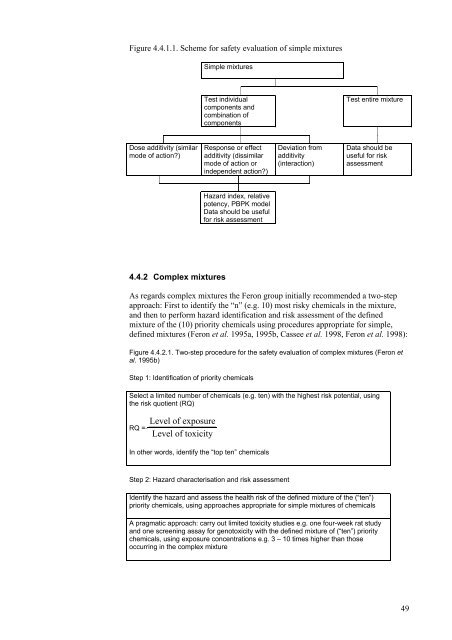Combined Actions and Interactions of Chemicals in Mixtures
Combined Actions and Interactions of Chemicals in Mixtures
Combined Actions and Interactions of Chemicals in Mixtures
Create successful ePaper yourself
Turn your PDF publications into a flip-book with our unique Google optimized e-Paper software.
Figure 4.4.1.1. Scheme for safety evaluation <strong>of</strong> simple mixtures<br />
Dose additivity (similar<br />
mode <strong>of</strong> action?)<br />
4.4.2 Complex mixtures<br />
Simple mixtures<br />
Test <strong>in</strong>dividual<br />
components <strong>and</strong><br />
comb<strong>in</strong>ation <strong>of</strong><br />
components<br />
Response or effect<br />
additivity (dissimilar<br />
mode <strong>of</strong> action or<br />
<strong>in</strong>dependent action?)<br />
Hazard <strong>in</strong>dex, relative<br />
potency, PBPK model<br />
Data should be useful<br />
for risk assessment<br />
Deviation from<br />
additivity<br />
(<strong>in</strong>teraction)<br />
Test entire mixture<br />
Data should be<br />
useful for risk<br />
assessment<br />
As regards complex mixtures the Feron group <strong>in</strong>itially recommended a two-step<br />
approach: First to identify the “n” (e.g. 10) most risky chemicals <strong>in</strong> the mixture,<br />
<strong>and</strong> then to perform hazard identification <strong>and</strong> risk assessment <strong>of</strong> the def<strong>in</strong>ed<br />
mixture <strong>of</strong> the (10) priority chemicals us<strong>in</strong>g procedures appropriate for simple,<br />
def<strong>in</strong>ed mixtures (Feron et al. 1995a, 1995b, Cassee et al. 1998, Feron et al. 1998):<br />
Figure 4.4.2.1. Two-step procedure for the safety evaluation <strong>of</strong> complex mixtures (Feron et<br />
al. 1995b)<br />
Step 1: Identification <strong>of</strong> priority chemicals<br />
Select a limited number <strong>of</strong> chemicals (e.g. ten) with the highest risk potential, us<strong>in</strong>g<br />
the risk quotient (RQ)<br />
RQ =<br />
Level <strong>of</strong> exposure<br />
Level <strong>of</strong> toxicity<br />
In other words, identify the “top ten” chemicals<br />
Step 2: Hazard characterisation <strong>and</strong> risk assessment<br />
Identify the hazard <strong>and</strong> assess the health risk <strong>of</strong> the def<strong>in</strong>ed mixture <strong>of</strong> the (“ten”)<br />
priority chemicals, us<strong>in</strong>g approaches appropriate for simple mixtures <strong>of</strong> chemicals<br />
A pragmatic approach: carry out limited toxicity studies e.g. one four-week rat study<br />
<strong>and</strong> one screen<strong>in</strong>g assay for genotoxicity with the def<strong>in</strong>ed mixture <strong>of</strong> (“ten”) priority<br />
chemicals, us<strong>in</strong>g exposure concentrations e.g. 3 – 10 times higher than those<br />
occurr<strong>in</strong>g <strong>in</strong> the complex mixture<br />
49

















